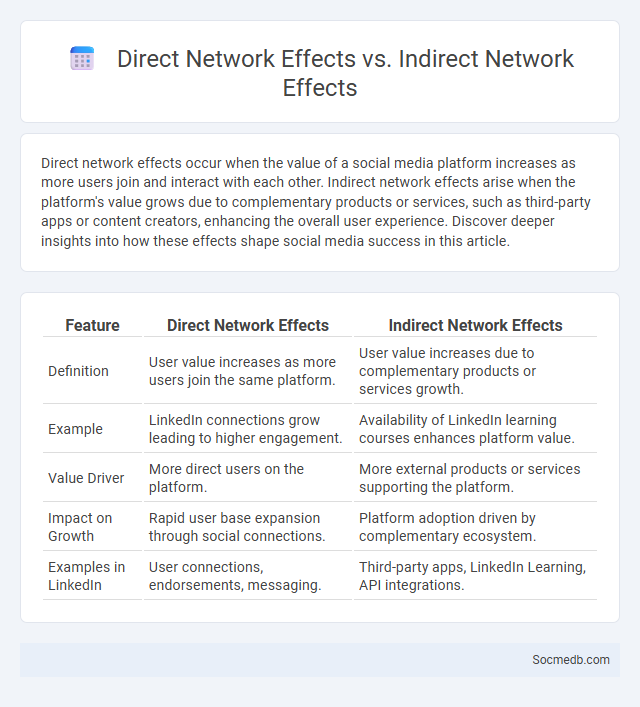
Photo illustration: Direct Network Effects vs Indirect Network Effects
Direct network effects occur when the value of a social media platform increases as more users join and interact with each other. Indirect network effects arise when the platform's value grows due to complementary products or services, such as third-party apps or content creators, enhancing the overall user experience. Discover deeper insights into how these effects shape social media success in this article.
Table of Comparison
| Feature | Direct Network Effects | Indirect Network Effects |
|---|---|---|
| Definition | User value increases as more users join the same platform. | User value increases due to complementary products or services growth. |
| Example | LinkedIn connections grow leading to higher engagement. | Availability of LinkedIn learning courses enhances platform value. |
| Value Driver | More direct users on the platform. | More external products or services supporting the platform. |
| Impact on Growth | Rapid user base expansion through social connections. | Platform adoption driven by complementary ecosystem. |
| Examples in LinkedIn | User connections, endorsements, messaging. | Third-party apps, LinkedIn Learning, API integrations. |
Introduction to Network Effects
Network effects occur when the value of a social media platform increases as more users join and engage, creating a self-reinforcing cycle of growth and interaction. Your experience on these platforms improves as connections multiply, leading to enhanced content sharing, community building, and real-time communication. Understanding network effects helps you leverage social media's power for marketing, influence, and expanding reach.
Defining Direct Network Effects
Direct network effects occur when the value of a social media platform increases as more users join and actively engage on it. Each new participant enhances user experience by expanding the potential for interactions such as messaging, sharing content, and forming connections. This phenomenon drives user retention and growth by making the platform more attractive with every additional member.
Understanding Indirect Network Effects
Indirect network effects arise on social media platforms when the value of the service increases as more complementary users or content creators join the network, enhancing overall engagement. For instance, a growing number of advertisers attract more users who benefit from relevant content and offers, while user growth entices additional advertisers, creating a positive feedback loop. Understanding these dynamics is crucial for social media companies seeking scalable growth and sustainable competitive advantage.
Key Differences: Direct vs Indirect Network Effects
Direct network effects in social media occur when the value of the platform increases as more users join and interact, such as on Facebook where user connections and content sharing drive engagement. Indirect network effects arise when the growth of complementary services or content improves the platform's value, exemplified by Instagram benefiting from third-party apps and influencer marketing ecosystems. Understanding these distinctions helps platforms optimize user acquisition strategies and enhance overall engagement.
Real-World Examples of Direct Network Effects
Instagram's rapid growth demonstrates direct network effects as each new user increases the platform's value by expanding content diversity and user interactions. Facebook's user engagement intensifies exponentially with more connections, reinforcing its dominance through a larger, more active network. LinkedIn benefits from direct network effects as professionals join to access a broader range of industry contacts, making the platform increasingly essential for career development.
Real-World Examples of Indirect Network Effects
Platforms like Instagram and TikTok showcase indirect network effects through user engagement and third-party content creators enhancing value for everyone involved. As more brands and influencers generate diverse content, Your experience becomes richer and more personalized, attracting even larger audiences. This cycle increases platform utility without direct connections between all users, demonstrating the power of complementary goods and services.
How Network Effects Drive Value Creation
Network effects in social media occur when the platform's value increases as more users join, fostering greater interaction and content sharing. Your network's growth enhances engagement, attracting advertisers and boosting platform revenue. This cycle of expanding connections drives continuous value creation for both users and the social network itself.
Challenges and Limitations of Network Effects
Network effects in social media create significant challenges such as increased platform monopolization, which stifles competition and innovation by favoring established networks with larger user bases. These effects also lead to echo chambers and filter bubbles, as users tend to connect with similar opinions, limiting exposure to diverse perspectives. Moreover, user privacy concerns and data misuse intensify under network effects, complicating regulatory efforts and diminishing user trust.
Strategies to Leverage Network Effects for Growth
Maximizing network effects on social media involves creating engaging content that encourages user interaction and sharing, thereby increasing platform visibility and user acquisition. Implementing referral programs and incentivizing users to invite connections can exponentially expand the user base while strengthening community bonds. Leveraging data analytics to identify influencers and target highly connected users also amplifies network growth by tapping into existing social circles.
Conclusion: Choosing the Right Network Effect Model
Selecting the right network effect model is crucial for maximizing user engagement and long-term growth on social media platforms. Your choice impacts how users interact, share content, and derive value from the network, directly influencing platform retention and monetization strategies. Understanding the nuances of direct, indirect, and two-sided network effects enables strategic decisions that optimize platform success in a competitive digital landscape.
 socmedb.com
socmedb.com